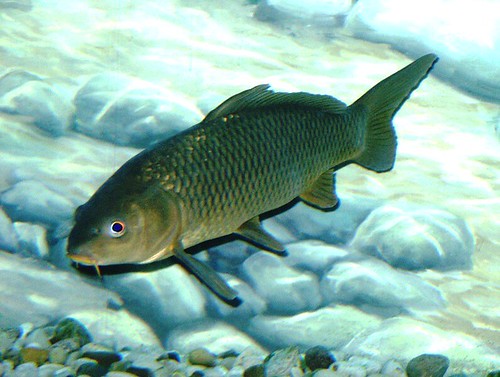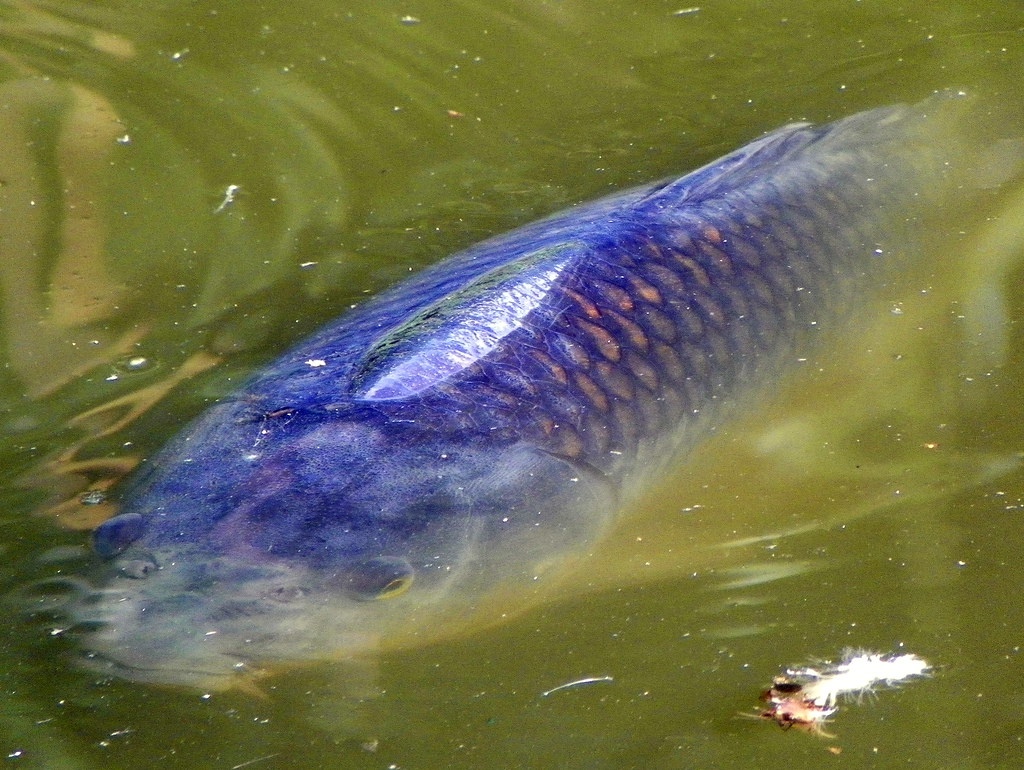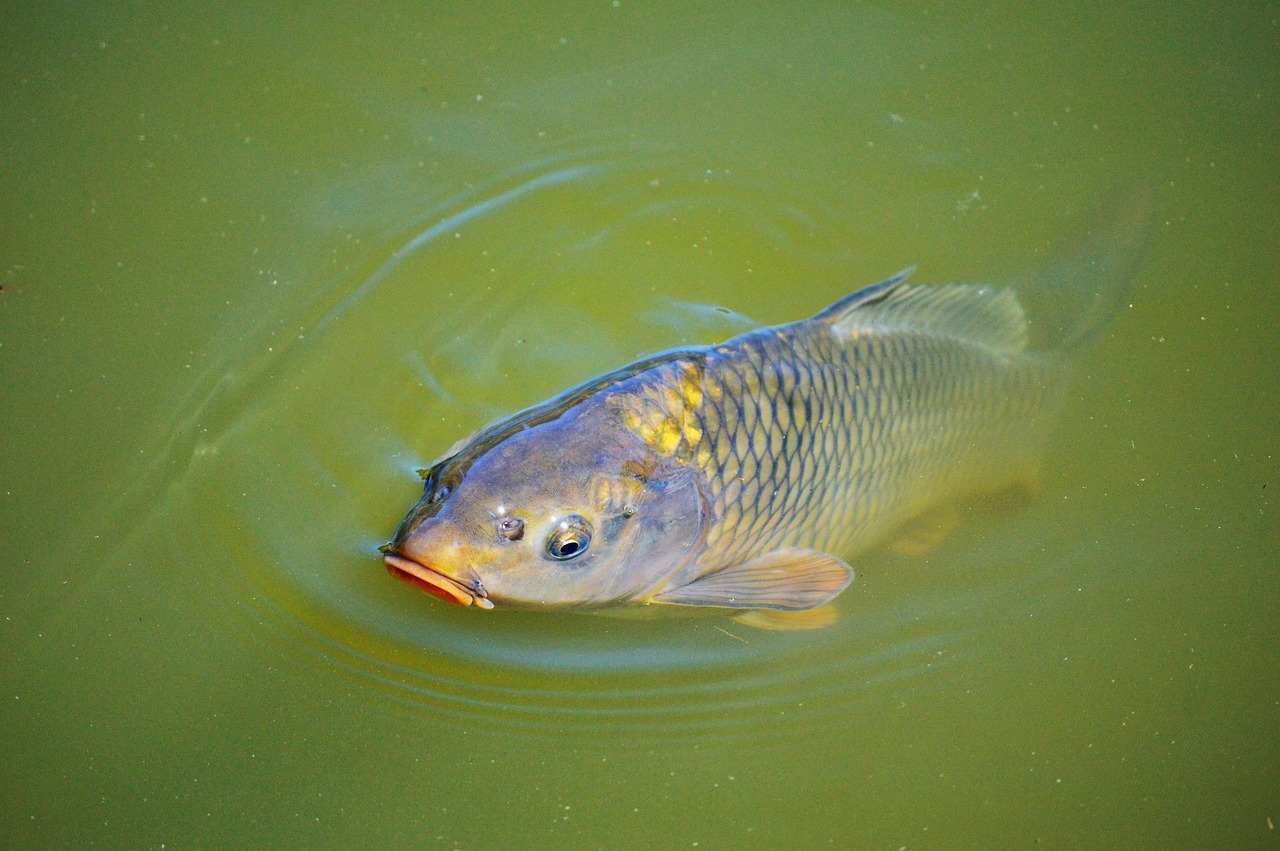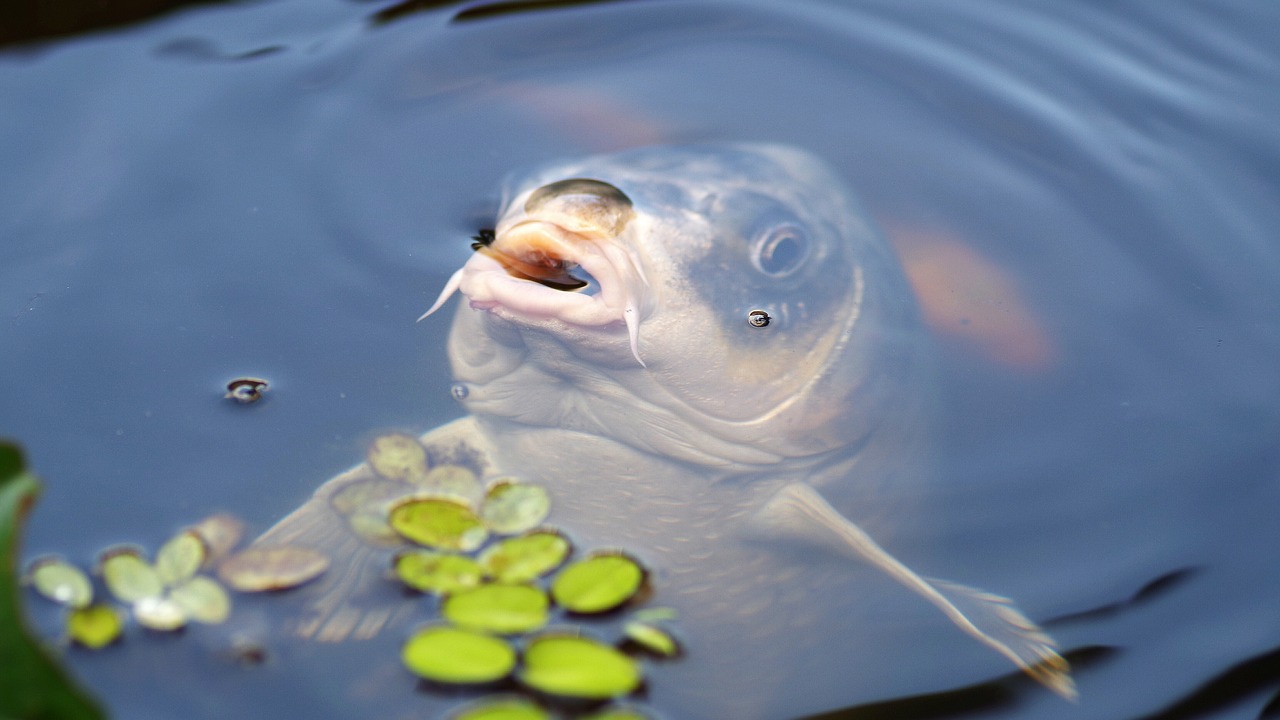Common carp
Cyprinus carpio
For a long time Carp has been domesticated for food and ornamental purposes in both Europe and Asia (famously the colorful japanese koi carp).
The most important element in the history of European carp was the Danube river. The first clear encounter with the carp comes via the Romans. It seems that over 2000 years ago the Roman Empire was worried about incursions into its territory by tribes on the northern side of the Danube. To deter raids the Romans built a number of forts along the river mostly along the section between modern-day Vienna and Budapest. The soldiers in these forts needed to be fed and archaeological digs have show that freshwater fish were a regular part of their meals. Of all the fish bones unearthed by far the most numerous turn out to be the bones of carp.
This fish is found in almost all waters in Romania, except in mountain regions. It is a robust, strong and cunning fish, with a fleshy, downwards-turned mouth and two pairs of whiskers on the upper lip. The body length can reach 1 m, and can weight up to 50 or even 60 kg. The body is covered with large scales. The back is usually gray – blackish, with bluish-greenish shades, the sides are copper or yellowish, and the abdomen is whitish. The tail and fins are gray, with orange-red accents.
The common carp feasts on a herbivorous diet of aquatic plants, plant tubers, and seeds, but can also scavenge the bottom for insects, crustaceans, mollusks, worms, roe, and fish remains.
A typical adult female can lay 300,000 eggs in a single spawn, typically in the spring, although in response to rising water temperatures and rainfall, carp can spawn multiple times in a season. Carp roe is also a common staple in the local cuisine.
In many central European countries, carp is a traditional part of a Christmas Eve dinner. Hungarian fisherman’s soup, is prepared only with carp or mixed with other freshwater fish, as part of the traditional meal for Christmas Eve. A traditional Czech Christmas Eve dinner will contain a thick soup of carp’s head, and fried carp meat (sometimes the meat can be baked instead) along with potato salad.

Photographer: Robposse

Photographer: RPeter O Connor
Multă vreme, crapul a fost domesticit în scopuri alimentare și ornamentale atât în Europa, cât și în Asia (în special celebrul crap koi japonez, colorat).
Cel mai important element din istoria crapului european a fost fluviul Dunărea. Prima relatare clară despre crap vine prin intermediul romanilor. Se pare că acum peste 2000 de ani Imperiul Roman era preocupat de incursiunile în teritoriul său ale triburilor de pe malul nordic al Dunării. Pentru a descuraja raidurile, romanii au construit o serie de forturi de-a lungul râului, mai ales de-a lungul secțiunii dintre Viena și Budapesta de astăzi. Soldații din aceste forturi trebuiau hrăniți, iar săpăturile arheologice au arătat că peștii de apă dulce faceau parte în mod regular din meselor lor. Dintre toate oasele de pește descoperite, cele mai numeroase se dovedesc a fi oase de crap.
Acest peste se gaseste in aproape toate apele din Romania, cu exceptia regiunilor montane. Este un peste robust, puternic si viclean, cu gura carnoasa, intoarsa in jos si doua perechi de mustati pe buza superioara. Lungimea corpului poate ajunge până la 1 m și poate cântări până la 50 sau chiar 60 kg. Corpul este acoperit cu solzi mari. Spatele este de obicei cenușiu – negricios, cu nuanțe albastru-verzui, părțile laterale sunt aramii sau gălbui, iar abdomenul este albicios. Coada și aripioarele sunt gri, cu accente portocalii-roșii.
Crapul comun are o dietă erbivoră de plante acvatice, tuberculi de plante și semințe, dar poate, de asemenea, să curețe fundul după insecte, crustacee, moluște, viermi, icre și resturi de pește.
Un exemplar tipic de femelă adult poate depune 300.000 de icre într-o singură pontă, de obicei primăvara, deși ca răspuns la creșterea temperaturii apei și a precipitațiilor, crapul poate depune de mai multe ori într-un sezon. Icrele de crap sunt, de asemenea, un aliment de bază comun în bucătăria locală românească.
În multe țări din Europa Centrală, crapul este o parte tradițională a cinei de Ajunul Crăciunului. Ciorba de pescar maghiară, se prepară doar cu crap sau amestecată cu alți pești de apă dulce, ca parte a mesei tradiționale din Ajunul Crăciunului. O cină tradițională cehă de Ajunul Crăciunului va conține o supă groasă de cap de crap și carne de crap prăjită (uneori carnea poate fi coptă în schimb) împreună cu salată de cartofi.
Crap
Cyprinus carpio
Karpfen
Cyprinus carpio
Der Karpfen wird seit langem sowohl in Europa als auch in Asien zu Nahrungs- und Zierzwecken domestiziert (berühmt ist der farbenprächtige japanische Koi-Karpfen).
Das wichtigste Element in der Geschichte des europäischen Karpfens war die Donau. Die erste eindeutige Begegnung mit dem Karpfen findet sich bei den Römern. Es scheint, dass das Römische Reich vor über 2000 Jahren über das Eindringen von Stämmen auf der Nordseite der Donau in sein Gebiet besorgt war. Um Überfälle zu verhindern, errichteten die Römer eine Reihe von Kastellen entlang des Flusses, vor allem auf dem Abschnitt zwischen dem heutigen Wien und Budapest. Die Soldaten in diesen Kastellen mussten ernährt werden, und archäologische Ausgrabungen haben gezeigt, dass Süßwasserfische regelmäßig zu ihren Mahlzeiten gehörten. Von allen ausgegrabenen Fischknochen sind die Knochen des Karpfens bei weitem am zahlreichsten.
Dieser Fisch ist in fast allen Gewässern Rumäniens zu finden, außer in den Bergregionen. Er ist ein robuster, starker und schlauer Fisch mit einem fleischigen, nach unten gerichteten Maul und zwei Paar Schnurrhaaren an der Oberlippe. Er kann bis zu 1 m lang und bis zu 50 oder sogar 60 kg schwer werden. Der Körper ist mit großen Schuppen bedeckt. Der Rücken ist in der Regel grau – schwärzlich,
mit bläulich-grünlichen Schattierungen, die Seiten sind kupferfarben oder gelblich, und der Bauch ist weißlich. Der Schwanz und die Flossen sind grau mit orange-roten Akzenten.
Der gemeine Karpfen ernährt sich pflanzlich von Wasserpflanzen, Pflanzenknollen und Samen, kann aber auch den Bodengrund nach Insekten, Krustentieren, Weichtieren, Würmern, Rogen und Fischresten absuchen.
Ein typisches erwachsenes Weibchen kann bei einem einzigen Laichvorgang, der in der Regel im Frühjahr stattfindet, 300.000 Eier ablegen, obwohl Karpfen als Reaktion auf steigende Wasser-temperaturen und Regenfälle mehrmals in einer Saison laichen können. Karpfenrogen ist auch ein gängiges Grundnahrungsmittel in der lokalen Küche.
In vielen mitteleuropäischen Ländern ist Karpfen ein traditioneller Bestandteil des Weihnacht-sabendessens. Die ungarische Fischersuppe wird nur mit Karpfen oder gemischt mit anderen Süßwasserfischen zubereitet und ist Teil der traditionellen Mahlzeit am Heiligabend. Ein traditionelles tschechisches Heiligabendessen besteht aus einer dicken Suppe aus Karpfenkopf und gebratenem Karpfenfleisch (manchmal kann das Fleisch auch gebacken werden) zusammen mit Kartoffelsalat.

Photographer: Ralphs Fotos

Photographer: Daniel Wanke
Pendant longtemps, la carpe a été domestiquée à des fins alimentaires et ornementales en Europe et en Asie (célèbre carpe koi japonaise colorée).
L’élément le plus important dans l’histoire de la carpe européenne était le Danube. La première rencontre claire avec la carpe vient des Romains. Il semble qu’il y a plus de 2000 ans, l’Empire romain s’inquiétait des incursions sur son territoire de tribus du côté nord du Danube. Pour dissuader les raids, les Romains ont construit un certain nombre de forts le long de la rivière, principalement le long de la section entre la Vienne moderne et Budapest. Les soldats de ces forts avaient besoin d’être nourris et des fouilles archéologiques ont montré que le poisson d’eau douce faisait régulièrement partie de leurs repas. De toutes les arêtes de poisson déterrées, les plus nombreuses sont de loin les arêtes de carpe.
Ce poisson se trouve dans presque toutes les eaux de Roumanie, sauf dans les régions montagneuses. C’est un poisson robuste, fort et rusé, avec une bouche charnue tournée vers le bas et deux paires de moustaches sur la lèvre supérieure. La longueur du corps peut atteindre 1 m, et peut peser jusqu’à 50 voire 60 kg. Le corps est couvert de grandes écailles. Le dos est généralement gris – noirâtre, avec des nuances bleuâtres-verdâtres, les côtés sont cuivrés ou jaunâtres et l’abdomen est blanchâtre. La queue et les nageoires sont grises, avec des accents rouge orangé.
La carpe commune se nourrit d’un régime herbivore de plantes aquatiques, de tubercules de plantes et de graines, mais peut également fouiller le fond à la recherche d’insectes, de crustacés, de mollusques, de vers, d’œufs et de restes de poisson.
Une femelle adulte typique peut pondre 300 000 œufs en une seule ponte, généralement au printemps, bien qu’en réponse à la hausse des températures de l’eau et des précipitations, la carpe puisse pondre plusieurs fois au cours d’une saison. Les œufs de carpe sont également un aliment de base commun dans la cuisine locale.
Dans de nombreux pays d’Europe centrale, la carpe fait traditionnellement partie du dîner du réveillon de Noël. La soupe du pêcheur hongrois, est préparée uniquement avec de la carpe ou mélangée à d’autres poissons d’eau douce, dans le cadre du repas traditionnel du réveillon de Noël. Un dîner tchèque traditionnel du réveillon de Noël contiendra une soupe épaisse de tête de carpe et de la viande de carpe frite (parfois la viande peut être cuite à la place) ainsi qu’une salade de pommes de terre.
Carpe commune
Cyprinus carpio
Try using these colors:
Remember, there are always more colors than you think you see!







